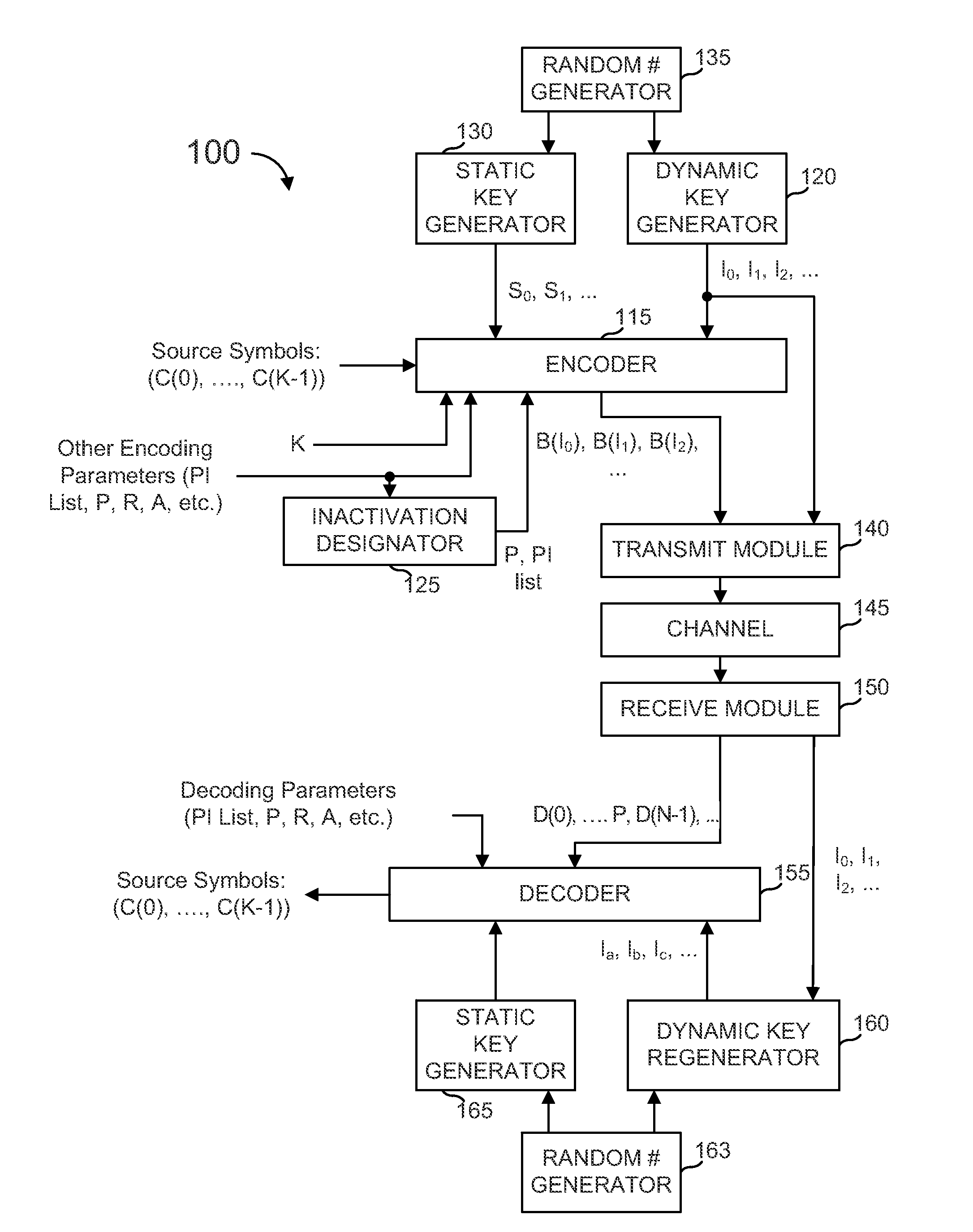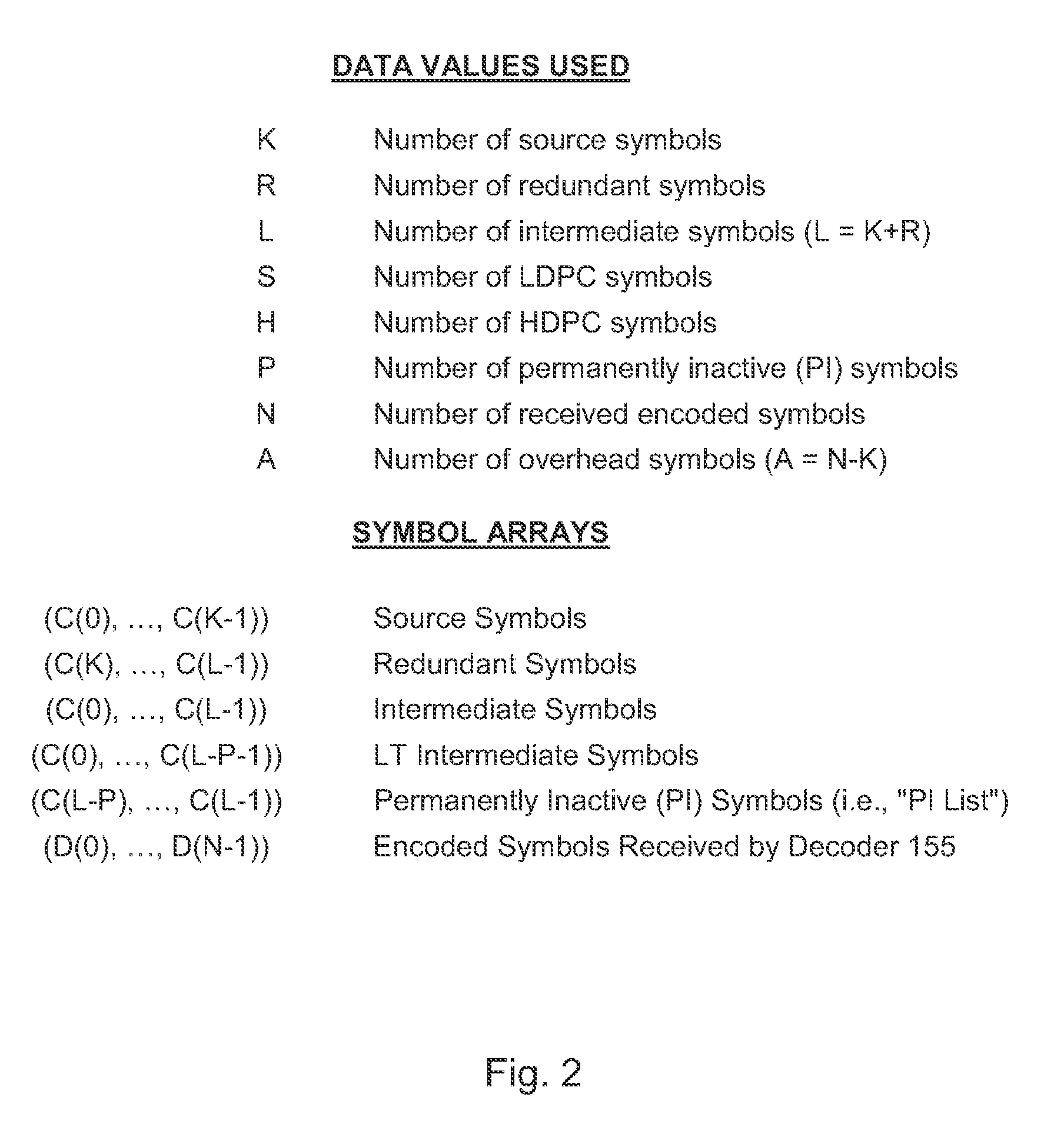Methods and apparatus employing fec codes with permanent inactivation of symbols for encoding and decoding processes
a technology of fec codes and symbols, applied in the field of encoding and decoding data in communications systems, can solve the problems of low computational complexity of chain reaction encoding and decoding processes, source data might not be entirely recoverable, and relatively computationally intensive, so as to reduce the computational cost of encoding data for transmission over a channel, reduce the computational cost of decoding such data, and reduce the absolute and relative reception overhead
- Summary
- Abstract
- Description
- Claims
- Application Information
AI Technical Summary
Benefits of technology
Problems solved by technology
Method used
Image
Examples
example hardware
Components
[0224]FIGS. 30-31 illustrate block diagrams of hardware that might be used to implement methods described above. Each element can be hardware, program code or instructions executed by a general purpose or custom-purpose processor or a combination.
[0225]FIG. 30 illustrates an example encoding system 1000, that might be implemented as hardware modules, software modules, or portions of program code stored in a program store 1002 and executed by a processor 1004, possibly as a collective unit of code not separated as shown in the figure. Encoding system 1000 receives a signal in, conveying source symbols and parameter information, and outputs a signal conveying that information.
[0226]An input interface 1006 stores the incoming source symbols into a source symbol buffer 1008. A source-to-intermediate symbol generator 1010 generates intermediate symbols from the source symbols. This can be a pass-through in some embodiments and a decoder module in other embodiments (such as a “s...
example 1
[0299]Inputs:[0300]SS=5[0301]Al=4 bytes[0302](Min sub-symbol size=20 bytes)[0303]WS=128 KB=131,072 bytes[0304]P′=1,240 bytes[0305]F=6 MB=6,291,456 bytes
[0306]Calculations:[0307]T=1,240 bytes[0308]Kt=5,074[0309]N_max=62[0310]KL(N_max)=6,553[0311]Z=1[0312]KL=ceil(Kt / Z)=5,074[0313]N=52 (KL(N)=5,461)[0314]TL=6, larger sub-symbol=24 bytes[0315]TS=5, smaller sub-symbol=20 bytes[0316]TL*AL*KL=121,776
example 2
[0317]Inputs:[0318]SS=8[0319]Al=4 bytes[0320](Min sub-symbol size=32 bytes)[0321]WS=128 KB=131,072 bytes[0322]P′=1 KB=1,024 bytes[0323]F=56,404 KB=57,757,696 bytes
[0324]Calculations:[0325]T 32 1,024 bytes[0326]Kt=56,404[0327]N_max=32[0328]KL(N_max)=4,096[0329]Z=14[0330]KL=ceil(Kt / Z)=4,029[0331]N=32 (KL(N)=4,096)[0332]TL=8, larger sub-symbol=32 bytes[0333]TS=8, smaller sub-symbol=32 bytes[0334]TL*AL*KL=128,928
[0335]There are many variants of the above methods. For example, for some FEC code it is desirable to have at least a minimum number of source symbols in a source block to minimize the source block reception overhead of the FEC code. Since for really small file sizes or data block sizes F the size of the source symbol might become too small, there might also be a maximum number of source symbols into which a packet is partitioned. For example, in IETF RFC 5053, the desired minimal number of source symbols in a source block is Kmin=1024 and the maximum number of source symbols in...
PUM
 Login to View More
Login to View More Abstract
Description
Claims
Application Information
 Login to View More
Login to View More - R&D
- Intellectual Property
- Life Sciences
- Materials
- Tech Scout
- Unparalleled Data Quality
- Higher Quality Content
- 60% Fewer Hallucinations
Browse by: Latest US Patents, China's latest patents, Technical Efficacy Thesaurus, Application Domain, Technology Topic, Popular Technical Reports.
© 2025 PatSnap. All rights reserved.Legal|Privacy policy|Modern Slavery Act Transparency Statement|Sitemap|About US| Contact US: help@patsnap.com



